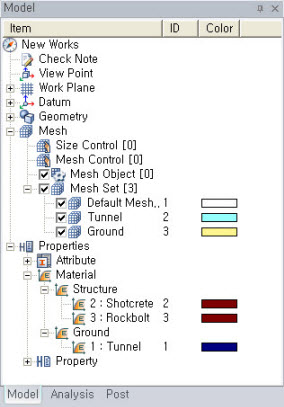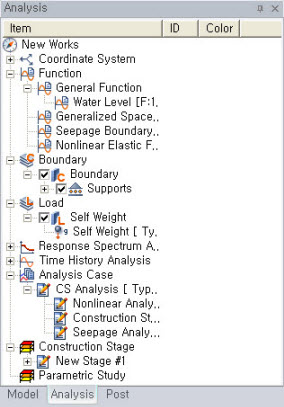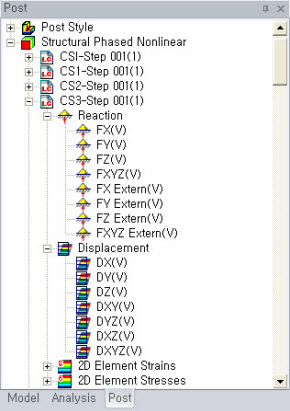Works Tree

GTS provides three Works Tree windows (Model, Post and Analysis), depending on the working modes.
Each Works Tree window can be positioned anywhere within the program. Hiding/Showing of the windows can be controlled through <Window> in the Main Menu.



The Pre-Works Tree is structured similar to the Windows Explorer. It stores all the pre-processing modeling information of geometry, mesh, load and boundary conditions. The user can also perform the basic modeling operation using the Pre-Works Tree, such as Show/Hide objects.
The featured functions of the Pre-Works Tree are as follows.
Selection Capability
The user can select objects from the Pre-Works Tree as well as from the Work Window. The item name, ID, and color code can be directly seen from the Pre-Works Tree.
The selection method in Pre-Works Tree is similar to MS Window Explorer. Thus, a single entity can be selected by left-clicking the mouse, and multiple entities can be selected by using the <Shift> and <Ctrl> keys.
Customized Context Menu
Depending on the selected entity, the Pre-Works
Tree provides a customized Context Menu which includes a range of practical
operations such as the Show/Hide function. When dealing with a complex
model, the user often has trouble selecting and modifying entities from
the Work Window. However, using Works Tree and its Context Menu, they
can select and modify the entities much more easily and conveniently.
 Since the
Context Menu changes depending on the selected entity, the user must try
out each case.
Since the
Context Menu changes depending on the selected entity, the user must try
out each case.
Familiar Working Environment
The Works Tree provides similar working environment
to the Microsoft Windows Explorer so that the user can quickly become
familiar with operating various functions such as Rename, Delete and Move,
in the Works Tree. After the desired items are selected, <Del>
key can be used to delete them, and <F2>
key for renaming. In the Works Tree, Mesh Sets can be moved or merged
by a simple Drag & Drop?using the mouse . Dragging the mesh set with
the left button of mouse will merge the sets, and dragging with the right
button of mouse will move the set below the other set.
 To merge multiple sets at once, use <Merge> function in the Context
Menu after selecting the sets.
To merge multiple sets at once, use <Merge> function in the Context
Menu after selecting the sets.
Once the analysis is completed, the program automatically brings the post data and arranges it in a tree format. In the Post-Works Tree, the user can control most of the output results, such as the graphic and table related display. It also can store the current display output.
The analysis results will be stored in Analysis Step > Result Type > Result Data.
The contour plot will be drawn by double-clicking the result data. Also,
from the Context Menu, numerical results can be generated in a table format.
The Analysis-Works Tree is structured similar to the Windows Explorer. It stores all the boundary conditions, loads, functions, Construction Stages that are required before running the analysis.